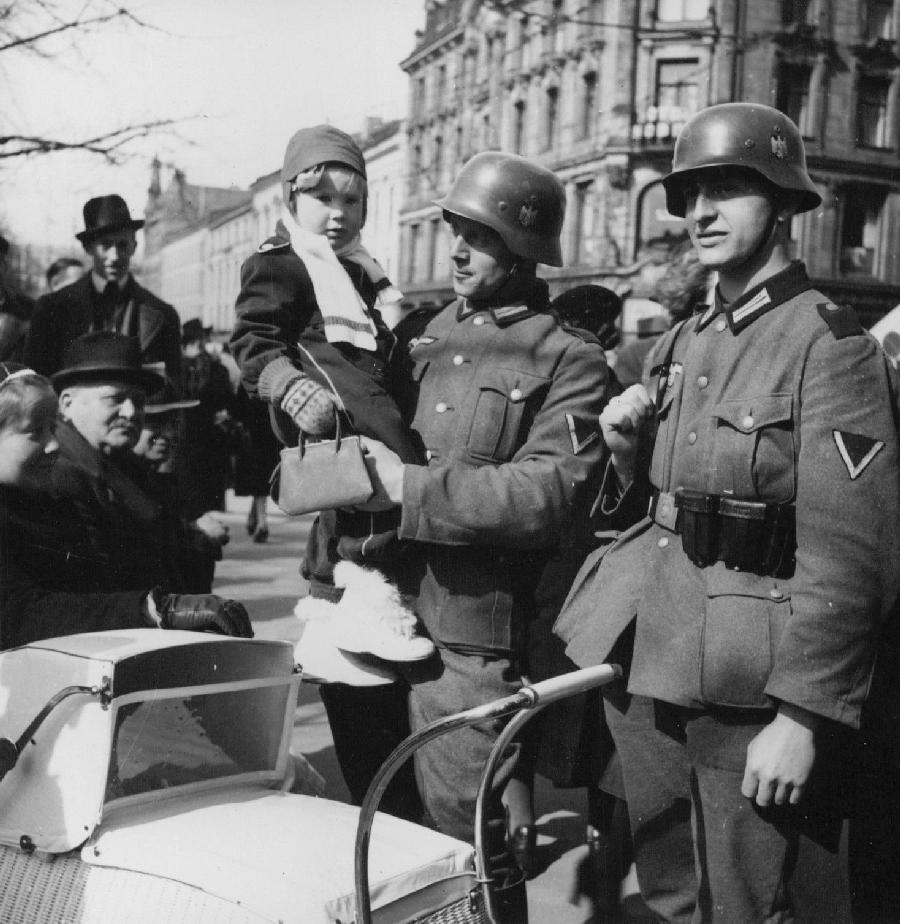
World War II Norway: German Occupation Policies

Figure 1.--The Germans occupied Norway for most of the War. And they exploited the country to support the war effort. They were not as brutal in Norway as they were in most other countries, at least in relative terms. This was because the population was largely Nordic--more Nordic than the Germans. This was a major factor in German occupation policies. Notice that we do not see German soldiers holding babies in other countries. This photograph was taken early in the occupation, October 1940.
|
|
German military forces (Heer, Luftwaffe, and Kriegsmarine) stationed in Norway were under the direct command of the Oberkommando der Wehrmacht i(OKW). Political power was vested in the Reich Commissioner (RC). The Germans attmpted to reach a Danish-like accomodation with the Norwegians. King Haakon and the Nygaardsvold Government refused. The Germans than attempted to negotiare with the Storting. But then Hitler decided to to give Quisling and the NS a chance (September 1940). In the end, the Reich Commisioner Josef Terboven maintained control theough the Reichskommissariat. He issued a range of regulations designed to support the German war effort.
He banned all political parties except Quisling's NS and appointed a new council of ministers--mostly NS men. Later it was replaced by an entirely NAZI Government with Quisling as a figurehead minister-president (February 1942). Power lay with RC Treboven. He appointed NS members to positions of authority down to towms and villages. Labour unions and other organizations had to accept NS leaders. Although Norwegians resented both the Germans and the NS there was little choice, but to cooperate for economic reasons. The German occupation cut off Norway from its major trading partners. And this meant food imports. Thus Norewgians suffered severe shortages. Making it very dificult to resist the Germans. The Norwegian Central Bank accomodated the RC needs and policy directives. The Norges Bank’s directors, including Governor Nikolai Rygg, decided stay in their positions during the occupation. And the Germans found no need to replace them. They gave the RC and the Wehrmacht unlimited access to the Bank’s printing press and thus all the bank notes they desired. as in other occupied countries, the Germans exploited the Norway, both directly and indirectly. One of the principal methods was to overvalue the Reich mark. There were also a range of forced subsidies. [Boldorf and Okazaki]
The Germans obtained both aliminum and pyrite in Norway for the armaments industry. Fish was also shipped to the Reich, but the essential value of Norway was to ensure the seasonal transport of Swedish iron ore to Germany. The RC also implemented NAZI racial laws. This meant that the population was decently treted on peronal basis, at least in relative terms. As in all occupied countries, the NAZIs set up concentration camps. People showing any sign of resistance were arrested, totaling some 44,000 people. The Germans deported 9,000 of those arrested to camps in Germany. [Libæk, Stenersen, and Sveen] At the same time the Germans brought in slave laborers (mostly Soviet, Polish, and Yugoslav) who were brutally treated. Labor waneeded to build coastal defenses as part of Hitler's Atlantic Wall. The racial laws affected Norway much less than most countries occupied by the Germans. The Morwegian population was Nordic and there was only a small Jewish population and more than half fled to Sweden. .
Sources
Boldorf, Marcel and Tetsuji Okazaki. Eds. Economies Under Occupation: The Hegemony of Nazi Germany and Imperial Japan in World War II .
Espeli, Harald. "Central banks under German rule during World War II: The case of Norway," Working Paper (Norges Bank’s Bicentenary Project.
Libæk, Ivar, Øyvind Stenersen, and Asle Sveen. History of Norway from 1814.
CIH - WW II

Navigate the CIH World War II Section :
[Return to Main World War II German occupation of Norway page ]
[Return to Main World War II Norwegisn page ]
[Return to Main World War II country page ]
[Return to Main World War II displaced children page]
[About Us]
[Biographies]
[Campaigns]
[Children]
[Countries]
[Deciding factors]
[Diplomacy]
[Geo-political crisis]
[Economics]
[Home front]
[Intelligence]
[POWs]
[Resistance]
[Race]
[Refugees]
[Technology]
[Totalitarian powers]
[Bibliographies]
[Contributions]
[FAQs]
[Images]
[Links]
[Registration]
[Tools]
[Return to Main World War II page]
[Return to Main war essay page]
[Return to CIH Home page]
Created: 8:10 AM 4/22/2016
Last updated: 8:10 AM 4/22/2016



